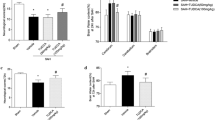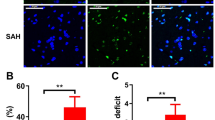Abstract
Neuronal apoptosis is one of the essential mechanisms of early brain injury after subarachnoid hemorrhage (SAH). Recently, HLY78 has been shown to inhibit apoptosis in tumor cells and embryonic cells caused by carbon ion radiation through activation of the Wnt/β-catenin pathway. This study was designed to explore the anti-apoptotic role of HLY78 in experimental SAH. The results demonstrated that HLY78 attenuated neuronal apoptosis and the neurological deficits after SAH through the activation of low-density lipoprotein receptor-related protein 6 (LRP6), which subsequently increased the level of phosphorylated glycogen synthesis kinase 3 beta (p-GSK3β) (Ser9), β-catenin, and Bcl-2, accompanied by a decrease of p-β-catenin, Bax, and cleaved caspase 3. An LRP6 small-interfering ribonucleic acid reversed the effects of HLY78. In conclusion, HLY78 attenuates neuronal apoptosis and improves neurological deficits through the LRP6/GSK3β/β-catenin signaling pathway after SAH in rats. HLY78 is a promising therapeutic agent to attenuate early brain injury after SAH.








Similar content being viewed by others
References
Lawton MT, Vates GE. Subarachnoid hemorrhage. N Engl J Med 2017, 377: 257–266.
Nath S, Koziarz A, Badhiwala JH, Almenawer SA. Predicting outcomes in aneurysmal subarachnoid haemorrhage. BMJ 2018, 360: k102.
Macdonald RL, Schweizer TA. Spontaneous subarachnoid haemorrhage. Lancet 2017, 389: 655–666.
Fujii M, Yan J, Rolland WB, Soejima Y, Caner B, Zhang JH. Early brain injury, an evolving frontier in subarachnoid hemorrhage research. Transl Stroke Res 2013, 4: 432–446.
Hu HM, Li B, Wang XD, Guo YS, Hui H, Zhang HP, et al. Fluoxetine is neuroprotective in early brain injury via its anti-inflammatory and anti-apoptotic effects in a rat experimental subarachnoid hemorrhage model. Neurosci Bull 2018, 34: 951–962.
Joiner DM, Ke J, Zhong Z, Xu HE, Williams BO. LRP5 and LRP6 in development and disease. Trends Endocrinol Metab 2013, 24: 31–39.
Tamai K, Semenov M, Kato Y, Spokony R, Liu C, Katsuyama Y, et al. LDL-receptor-related proteins in Wnt signal transduction. Nature 2000, 407: 530–535.
Zeng X, Tamai K, Doble B, Li S, Huang H, Habas R, et al. A dual-kinase mechanism for Wnt co-receptor phosphorylation and activation. Nature 2005, 438: 873–877.
Wang S, Yin J, Chen D, Nie F, Song X, Fei C, et al. Small-molecule modulation of Wnt signaling via modulating the Axin-LRP5 interaction. Nat Chem Biol 2013, 9:579–585.
Li H, Yue L, Xu H, Li N, Li J, Zhang Z, et al. Curcumin suppresses osteogenesis by inducing miR-126a-3p and subsequently suppressing the WNT/LRP6 pathway. Aging (Albany NY) 2019, 11: 6983–6998.
Ren DN, Chen J, Li Z, Yan H, Yin Y, Wo D, et al. LRP5/6 directly bind to Frizzled and prevent Frizzled-regulated tumor metastasis. Nat Commun 2015, 6: 6906.
Wang Z, Li B, Zhou L, Yu S, Su Z, Song J, et al. Prodigiosin inhibits Wnt/β-catenin signaling and exerts anticancer activity in breast cancer cells. Proc Natl Acad Sci U S A 2016, 113: 13150–13155.
Wang Y, Bao DJ, Xu B, Cheng CD, Dong YF, Wei XP, et al. Neuroprotection mediated by the Wnt/Frizzled signaling pathway in early brain injury induced by subarachnoid hemorrhage. Neural Regen Res 2019, 14: 1013–1024.
Si J, Zhou R, Zhao B, Xie Y, Gan L, Zhang J, et al. Effects of ionizing radiation and HLY78 on the zebrafish embryonic developmental toxicity. Toxicology 2019, 411: 143–153.
Guo X, Zhang L, Fan Y, Zhang D, Qin L, Dong S, et al. Oxysterol-binding protein-related protein 8 inhibits gastric cancer growth through induction of ER stress, inhibition of Wnt signaling, and activation of apoptosis. Oncol Res 2017, 25: 799–808.
Xie Z, Huang L, Enkhjargal B, Reis C, Wan W, Tang J, et al. Recombinant netrin-1 binding UNC5B receptor attenuates neuroinflammation and brain injury via PPARγ/NFκB signaling pathway after subarachnoid hemorrhage in rats. Brain Behav Immun 2018, 69: 190–202.
Wang X, Li S, Ma J, Wang C, Chen A, Xin Z, et al. Effect of gastrodin on early brain injury and neurological outcome after subarachnoid hemorrhage in rats. Neurosci Bull 2019, 35: 461–470.
Sugawara T, Ayer R, Jadhav V, Zhang JH. A new grading system evaluating bleeding scale in filament perforation subarachnoid hemorrhage rat model. J Neurosci Methods 2008, 167: 327–334.
Zhang T, Wu P, Budbazar E, Zhu Q, Sun C, Mo J, et al. Mitophagy reduces oxidative stress via Keap1 (Kelch-Like Epichlorohydrin-Associated Protein 1)/Nrf2 (Nuclear Factor-E2-Related Factor 2)/PHB2 (Prohibitin 2) pathway after subarachnoid hemorrhage in rats. Stroke 2019, 50: 978–988.
Li P, Zhao G, Ding Y, Wang T, Flores J, Ocak U, et al. Rh-IFN-α attenuates neuroinflammation and improves neurological function by inhibiting NF-κB through JAK1-STAT1/TRAF3 pathway in an experimental GMH rat model. Brain Behav Immun 2019, 79: 174–185.
Xie Z, Huang L, Enkhjargal B, Reis C, Wan W, Tang J, et al. Intranasal administration of recombinant Netrin-1 attenuates neuronal apoptosis by activating DCC/APPL-1/AKT signaling pathway after subarachnoid hemorrhage in rats. Neuropharmacology 2017, 119: 123–133.
Yu J, Li X, Matei N, McBride D, Tang J, Yan M, et al. Ezetimibe, an NPC1L1 inhibitor, attenuates neuronal apoptosis through AMPK dependent autophagy activation after MCAO in rats. Exp Neurol 2018, 307: 12–23.
Ostrowski RP, Colohan AR, Zhang JH. Molecular mechanisms of early brain injury after subarachnoid hemorrhage. Neurol Res 2006, 28: 399–414.
Cahill J, Calvert JW, Zhang JH. Mechanisms of early brain injury after subarachnoid hemorrhage. J Cereb Blood Flow Metab 2006, 26: 1341–1353.
Ayer RE, Zhang JH. Oxidative stress in subarachnoid haemorrhage: significance in acute brain injury and vasospasm. Acta Neurochir Suppl 2008, 104: 33–41.
Zheng H, Jia L, Liu CC, Rong Z, Zhong L, Yang L, et al. TREM2 promotes microglial survival by activating Wnt/β-catenin pathway. J Neurosci 2017, 37: 1772–1784.
Gao K, Shen Z, Yuan Y, Han D, Song C, Guo Y, et al. Simvastatin inhibits neural cell apoptosis and promotes locomotor recovery via activation of Wnt/β-catenin signaling pathway after spinal cord injury. J Neurochem 2016, 138: 139–149.
Fernandez-Martos CM, Gonzalez-Fernandez C, Gonzalez P, Maqueda A, Arenas E, Rodriguez FJ. Differential expression of Wnts after spinal cord contusion injury in adult rats. PLoS One 2011, 6: e27000.
Hassan MQ, Maeda Y, Taipaleenmaki H, Zhang W, Jafferji M, Gordon JA, et al. MiR-218 directs a Wnt signaling circuit to promote differentiation of osteoblasts and osteomimicry of metastatic cancer cells. J Biol Chem 2012, 287: 42084–42092.
Yakisich JS, Azad N, Kaushik V, O’Doherty GA, Iyer AK. Nigericin decreases the viability of multidrug-resistant cancer cells and lung tumorspheres and potentiates the effects of cardiac glycosides. Tumour Biol 2017, 39: 1010428317694310.
Clevers H, Nusse R. Wnt/β-catenin signaling and disease. Cell 2012, 149: 1192–1205.
Abe T, Zhou P, Jackman K, Capone C, Casolla B, Hochrainer K, et al. Lipoprotein receptor-related protein-6 protects the brain from ischemic injury. Stroke 2013, 44: 2284–2291.
Endo H, Nito C, Kamada H, Yu F, Chan PH. Akt/GSK3beta survival signaling is involved in acute brain injury after subarachnoid hemorrhage in rats. Stroke 2006, 37: 2140–2146.
Ma J, Wang Z, Liu C, Shen H, Chen Z, Yin J, et al. Pramipexole-induced hypothermia reduces early brain injury via PI3K/AKT/GSK3β pathway in subarachnoid hemorrhage rats. Sci Rep 2016, 6: 23817.
Li X, Peng J, Pang J, Wu Y, Huang X, Li Y, et al. Apolipoprotein E-mimetic peptide COG1410 promotes autophagy by phosphorylating GSK-3β in early brain injury following experimental subarachnoid hemorrhage. Front Neurosci 2018, 12: 127.
Min JK, Park H, Choi HJ, Kim Y, Pyun BJ, Agrawal V, et al. The Wnt antagonist Dickkopf2 promotes angiogenesis in rodent and human endothelial cells. J Clin Invest 2011, 121: 1882–1893.
Lee SH, Ko HM, Kwon KJ, Lee J, Han SH, Han DW, et al. tPA regulates neurite outgrowth by phosphorylation of LRP5/6 in neural progenitor cells. Mol Neurobiol 2014, 49: 199–215.
Acknowledgments
This work was supported by the National Natural Science Foundation of China (81771961 and 81401505) and the Kuanren Talents Program of the Second Affiliated Hospital of Chongqing Medical University (201959).
Author information
Authors and Affiliations
Corresponding authors
Ethics declarations
Conflict of interest
The authors declare no potential conflict of interest.
Electronic supplementary material
Below is the link to the electronic supplementary material.
Rights and permissions
About this article
Cite this article
Luo, X., Li, L., Xu, W. et al. HLY78 Attenuates Neuronal Apoptosis via the LRP6/GSK3β/β-Catenin Signaling Pathway After Subarachnoid Hemorrhage in Rats. Neurosci. Bull. 36, 1171–1181 (2020). https://doi.org/10.1007/s12264-020-00532-4
Received:
Accepted:
Published:
Issue Date:
DOI: https://doi.org/10.1007/s12264-020-00532-4




